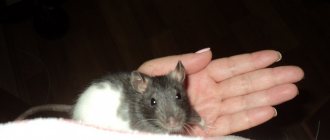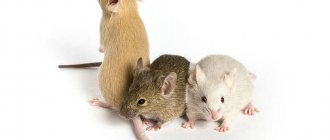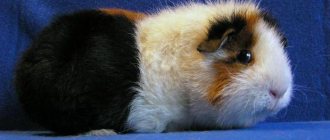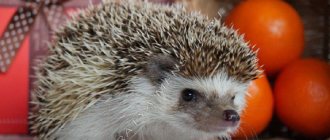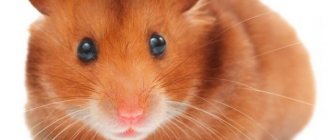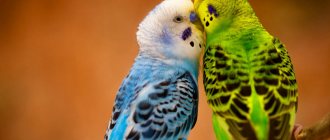How to tame an African pygmy hedgehog
To tame a hedgehog, you will need calm and patience.
To tame an animal, surround it with affection and care. Have regular conversations with your pet, create a safe and calm atmosphere for him. The hedgehog has poor eyesight and a very sensitive sense of smell. He will distinguish you by touch, smell, voice.
Try to carefully lift your pet by the abdomen. If he starts using needles, do it with a blanket or towel - the hedgehog will stop panicking and calm down. If attempts to pick up your pet are unsuccessful, do not be nervous. Under no circumstances should you yell at the animal, much less throw it! Instead, be level-headed but persistent.
The hedgehog is a nocturnal animal. Therefore, try not to disturb him during the day, especially in the first days after acquisition. To help your pet get used to you as quickly as possible, try to hand feed him as often as possible.
Talk to your pet in a calm, gentle voice. Hold it in your arms daily for 15–20 minutes. If you follow simple recommendations, the hedgehog will soon begin to approach you.
Pregnancy
Determining that a female is pregnant is difficult. Its body is covered with a shell with thick spines. They hide the completeness of the individual. Hedgehogs have enlarged sides, but this may be due to increased nutrition. Often members of the household find out that the female will have a new baby when a squeak is heard in the house.
Loading …
It is not recommended to palpate the belly; it can damage the cubs. The hedgehog may become calmer, more sedate, and stops running when walked.
After a week-long meeting with the male, the female is prescribed a high-calorie diet. Vitamins and calcium must be added to it. A hedgehog needs a lot of nutrients for the normal development of pregnancy and for the growth of cubs. Calories are reduced when the lactation period ends:
- the female is given insects;
- chicken is replaced with hearts and liver;
- all products are well boiled;
- insects must be safe;
- It is better to give boiled chicken eggs;
- The hedgehog is given sprouted wheat and oats, vegetables, fruits, berries;
- of vitamins, “Fitocalcevit” is administered for dogs; on the tip of a knife, add to the meat.
Pregnancy lasts 31 days, but the birth of a new baby is expected until the 35th day. During this period, the running wheel and high mazes are removed from the cage.
They install a larger house so that it can comfortably accommodate a mother and her offspring. In order for her to create a cozy nest, clean rags, paper napkins, and soft hay are placed in the cage.
Description and varieties
African pygmy hedgehogs come in a wide range of colors
The African pygmy hedgehog grows no more than 20 cm in length, and its weight is about 500 g. Individuals of this breed differ from each other in color.
Salt and pepper hedgehogs have black eyes, a mask and a nose. The number of black needles exceeds the number of non-pigmented ones. The skin around the ears and on the back is also black. There are spots of a similar color on the belly and paws.
Gray individuals have black eyes, a mask, and a nose. There are spots of the same shade on the belly and paws. The needles of this species are dark gray or dark brown. On the back and in the ear area, the color smoothly transitions from dark gray to black.
The brown variety of hedgehogs has light brown needles. The eyes are black, edged with blue. The mask of this individual is light brown in color. Chocolate nose. The belly and paws are evenly colored. The skin in the area of the back and ears has a pinkish tint with a gray tone.
The “chocolate” variety has brown needles. The eyes are black. The mask and nose are pale brown. The skin on the back and around the ears has a grayish tint. There may be barely noticeable spots on the abdomen and paws.
The “champagne” variety has light beige needles. Their mask is not expressed. The nose is pinkish. The back and ears are of a similar color. The eyes have a ruby tint. The belly and limbs of this individual are uniformly colored.
"Tsinakot" has half of the needles in a light brown tone, and the other part - pale beige. The mask practically does not appear. The nose is pink with brown specks. The eyes of this individual are black or ruby in color. The belly and paws are evenly colored. The skin on the back and around the ears is pinkish.
The “cinnamon” variety has a needle-like cover of a light brown tone. The mask practically does not appear. The nose is pinkish-brown. This individual has eyes of a black or dark ruby hue. The paws and belly are evenly colored. The skin on the back and ears is pink.
In addition to these varieties, any individual may exhibit a color anomaly:
- Pint - any part of the skin may not have pigmentation;
- Snowflake - 30–70% of needles become discolored;
- White - almost all needles are discolored.
A mammal can be born an albino. Animals with this abnormal coloration have white needles, pinkish skin and scarlet eyes.
“Specific feature” of this breed:
You need to know in advance that this breed has a specific feature - hedgehogs coat themselves with saliva .
Urine, and not only your own, can be used for the same purposes.
Animals do this for certain reasons - they feel fear and try to hide under a different smell , or they feel unwell and try to “lick their wounds.”
In any case, be prepared for the unexpected when picking up an African.
The very process of throwing saliva can scare you - you need to get used to it, because the sight is not a pleasant one.
Pros and cons of keeping a pygmy hedgehog
African hedgehogs are smart and energetic, but do not get along well with other animals.
Keeping an African hedgehog at home has many advantages:
- People who breed these animals claim that the hedgehog can relieve fatigue and even lower blood pressure;
- Hedgehogs are very smart creatures. They can quickly get used to their owner and become attached to him;
- The African pygmy hedgehog can be easily accustomed to the regime of eating, resting and communicating with the owner;
- The animal does not require much time to care for. It is enough to keep the cage clean, sometimes wash the pet and trim its claws;
- Hedgehogs very rarely make sounds. If this happens, then they are practically inaudible;
- The hedgehog has very compact dimensions. There is a place for it even in the smallest apartment;
- Since the animal lives in a cage, it will not damage your wallpaper, furniture and other valuables;
- Hedgehogs do not need to be walked. They relieve themselves in a certain corner of the cage;
- African pygmy hedgehogs are unpretentious in food. They can even eat regular cat food.
However, despite so many positive aspects, keeping a hedgehog also has its disadvantages:
- If you often let your pet out of the cage, you will have to collect needles around the apartment;
- The hedgehog is a nocturnal animal; it is not recommended to place its cage in a room where people sleep - it will interfere;
- The hedgehog has a highly developed hunting instinct. If there are other pets in the house, this character trait can cost the hedgehog his life;
- Not all veterinary clinics will be able to provide assistance to the African pygmy hedgehog. This is due to the fact that this animal is not particularly common in our country.
Many people may wonder if an animal has a foul odor. If you keep the animal's cage clean, and also monitor its health and proper nutrition, there will be no repulsive odor.
Diseases
Hedgehogs are prone to many diseases, including cancer and Wobbly Hedgehog Syndrome (WHS). Some symptoms of WHS resemble those of multiple sclerosis in humans, so the condition in animals can be compared to what patients with multiple sclerosis experience. These include the inability to move normally, tremors of the limbs, staggering when walking, etc. A possible cause of WHS is a genetic defect that allows the virus to attack the hedgehog’s nervous system.
The nose can exhibit a variety of alarming symptoms, especially respiratory illnesses such as pneumonia. In many cases, the form of pneumonia that affects hedgehogs is bacterial in nature. When acted quickly, antibiotics can have a very positive effect. Observable signs include blisters, excessive mucus production, or persistent sneezing.
Care and maintenance at home
In order for your pet to live as long as possible, you must follow a number of rules and recommendations.
What to feed
Insects are a real delicacy for a hedgehog
The hedgehog is a predatory animal. The best food for him is insects and meat . Specialized stores sell food. But it is still better to give preference to natural products.
It is recommended to feed the hedgehog boiled or steamed meat. For example, 1 tbsp. spoon of beef, chicken, turkey. The meat product must be finely chopped or minced before feeding. You can also give your pet chicken necks, stomachs, liver, etc. One serving requires 1–2 units of offal. Once a week, your pet can be given boiled or steamed fish.
Please note: any meat, poultry and fish should not contain salt and spices!
Among insects, hedgehogs prefer crickets and zofobus. But this food is quite fatty. Therefore, it can only be given a couple of times a week. The pygmy hedgehog is also fed with grasshoppers, mealworms, caterpillars, marbled cockroaches, and locusts.
The hedgehog will not refuse vegetables either. He loves zucchini, carrots, green beans, asparagus, pumpkin, cucumbers, broccoli, spinach, and bell peppers. Among fruits and berries, the hedgehog prefers apples, pears, bananas, peaches, watermelon, cherries (always pitted), strawberries, blueberries, raspberries, blueberries and kiwi.
You can diversify your pet's diet with a chicken or quail egg. It can be given in cool and raw form. The hedgehog also loves baby food.
Hygiene and bathing
Bathing an African pygmy hedgehog is a must. It is necessary not only to eliminate unpleasant odors, but also to remove dirt and parasites. Bathing is always a huge stress for the animal. The thorns take a long time to dry, and your pet can get a bad cold (especially in cold weather). That is why it is recommended to perform the procedure no more than 1-2 times a month. You cannot bathe weak, sick, or unadapted animals, otherwise you can cause irreparable harm to your prickly pet.
To perform hygiene procedures, fill a basin with approximately 5 liters of water. Her temperature should not be higher than 34.8 degrees. It is necessary to immerse the animal into the water slowly, lightly holding it by the upper part of the body. First of all, you need to thoroughly wash the paws and belly. After that, proceed to the back. The needles can be cleaned with baby shampoo and a soft toothbrush. Make sure that water does not get on the muzzle. After bathing, the animal must be wrapped in a warm towel. The hedgehog should dry naturally. Protect your pet from drafts.
Video: African hedgehog bathes
Diseases and treatment
African pygmy hedgehogs are susceptible to a wide range of diseases.
If they are well maintained, as a rule, hedgehogs rarely get sick. But you still need to know what problems you may encounter and how to treat them.
Pneumonia. This disease can occur as a result of hypothermia. The animal refuses food, often licks its nose, sneezes, and coughs. Breathing becomes difficult, characteristic clicks are heard. This pathological condition is treated with antibiotics.
The pet needs to be shown to a doctor. If this is not possible, veterinarians recommend treating the animal with Ceftriaxone or Catozal. To eliminate a runny nose, you can use saline solution to rinse the nose, children's "Farmozolin" or "Maksidin". The antibiotic is injected intramuscularly into the thigh. "Catozal" is applied to the fold of skin on the back.
Gastrointestinal disorders. The feces of the African hedgehog are elongated and approximately the diameter of a pencil. The color of the discharge in a healthy animal is dark brown. If there is mucus or bile in your pet's stool, this means that the hedgehog has impaired digestion. This often happens due to the introduction of new foods into the diet. Just exclude them from your diet and watch your stool. If nothing has changed within 2-3 weeks, consult a doctor. The animal may have an infection. If the color of the stool is healthy, but it resembles cow pats, it is necessary to cleanse the gastrointestinal tract. Cockroaches will help you with this. If you have diarrhea, make sure your pet drinks plenty of water. If he refuses, it is necessary to inject saline solution subcutaneously. To treat the stomach, you can use Nifuroxazide. If diarrhea does not go away for more than 2 days, consult a doctor.
Wounds, scratches, fractures. Wounds and scratches should be washed with hydrogen peroxide. After this, the damage must be treated with Chlorhexidine. Then you should wait a little and lubricate the wound with Levomekol. For serious injuries, only a veterinarian can help. Fractures usually require amputation.
Fungus. The animal's needles and fur fall out. The skin becomes crusty and peels off. In this situation, it is recommended to use Imaverol. A cube of medicine requires 50 cubes of water. Spray your pet with this solution 3 times a day.
Ticks, worms. When infected with a tick, scratches and wounds will appear on the animal's body. With worms, the animal loses weight even with a good appetite. There is mucus and bloody discharge in the stool. In this case, Stronghold, Frontline, and Advocate help. The exact dosage is described in the instructions.
Vaccination
African pygmy hedgehogs are treated only for external and internal parasites. These pets are not vaccinated; there are no special vaccines for them. In addition, animals have a weak liver, and any vaccination can be fatal or shorten their life several times.
Selecting a cage and accessories
The hedgehog needs to be provided with a sufficient level of comfort in the cage.
The animal's cage should be spacious, the bottom size should be at least 60*60 cm . It must be continuous. The distance between the rods should not be too large. The animal can crawl through them and escape, or get stuck between them.
Do not purchase multi-level cages for pygmy hedgehogs!
A running wheel must be placed in the cage. It must be solid, with a diameter of at least 28 cm. Depending on the nature of the animal in the cage, he needs to make a shelter. For a sociable hedgehog, you can simply lay a soft towel or blanket. A shy pet needs a house.
You need to put a food bowl and a drinking bowl in the cage. The bowl should be heavy so that the pet does not roll it around the cage. It is best to choose a nipple drinker.
Many hedgehogs love to play. Cat toys are perfect for them - for example, a ball with bells inside or tunnels.
Feeding
You shouldn’t think too much about what the African hedgehog eats. Premium cat food is perfect for him. It is natural and does not contain any flavors or other harmful additives. It is also necessary to ensure that the food does not contain starchy ingredients, such as corn or potatoes.
Since cat food is largely multi-component, it is good if it has a meat base. It could be chicken, beef or turkey. But don't forget about fruits and vegetables.
In addition to meat and plant products, sometimes you need to pamper hedgehogs with such unusual gifts as crickets, grasshoppers and zoophobes.
Breeding
Breeding African pygmy hedgehogs is a very important step. Initially, carefully weigh the pros and cons. You should have enough free time to care for your pregnant hedgehog and babies.
How to determine gender
To determine the sex, hold the hedgehog in your arms so that its belly is visible. In females, the genitals are located next to the anus. In males, they are located at a distance of approximately 1 cm from the anus in babies and 2–2.5 cm in adults.
Mating
For mating to be successful, the hedgehogs must be in the same age category
Hedgehogs become sexually mature at 5.5–6 weeks. Animals should not have inbreeding until at least the 3rd generation, so babies must be separated by gender in advance. Weak and sick hedgehogs cannot be bred.
A young male cannot be mated with an adult female. Due to inexperience, he can cause aggression and be bitten as a result. Mating can be done at 5.5–6 weeks, not earlier.
A female can become pregnant before 5.5 weeks. This cannot be allowed. She may not bear offspring or refuse to feed the cubs. A female should not be allowed to mate for more than 11 weeks if she has never given birth. Fused pelvic bones can complicate childbirth and lead to the death of a hedgehog.
Mating takes 6–7 days. There is no point in keeping animals together any longer. If mating does not occur, place the hedgehogs for a week, and then connect them again.
Males can be bred every 2 weeks. Female - no more than 2 times a year. Otherwise, she will kill her hedgehogs.
Pregnancy
Pregnancy in hedgehogs lasts 34–36 days. In a couple of weeks, the female gains 10–50 g in weight. On the 25th day, it is already clear that the hedgehog is pregnant: she becomes rounder, and her behavior also changes. She begins to take care of herself, her gait slows down.
How to care for newborn hedgehogs
It is better to touch newborn hedgehogs only with a cloth.
In the first days of the babies' lives, the female behaves very nervously. She needs to be placed in a separate cage and ensure complete rest. Otherwise, she may refuse to feed the offspring or even kill them.
It is better not to touch small hedgehogs - the female may refuse them if she smells a person . But sometimes situations arise when holding a baby is simply necessary. In this case, wash your hands thoroughly with plain water, put on clean clothes and try to avoid any odors. When you pick up the baby, distract the female. The same must be done when you put it back.
For the first 2 weeks, hedgehogs eat only mother's milk, then she begins to bring them other food. By 2 months, hedgehogs are no longer completely dependent on their mother.
What foods should I give?
Hedgehogs living in their natural environment obtain earthworms, mosquito larvae, dragonflies, and chafers.
All of this food can be purchased at a pet store, but many animal lovers raise worms and larvae at home. In separate terrariums they contain Zofobas, bloodworms, Uzbek or Madagascar cockroaches.
It is recommended to give insects not only to adults, but also to small hedgehogs. Adult animals receive worms, cockroaches and beetles in live or immobilized form. The young insects are dried, ground into powder and added to food.
Forest hedgehogs can destroy bird nests that are on the ground. They eat eggs and chicks. Beginners in zoology are interested in what hedgehogs eat when kept at home.
Pets can also be given eggs. An animal can drink 1 quail egg per day. It is recommended to boil chicken eggs. You can give ¼ teaspoon of the product per day.
In order not to kill the chicks, pets can be fed beef, horse meat or chicken. Meat can be introduced into the diet in the form of minced meat or cut into small pieces. Breeders recommend boiling the meat.
You can give boiled liver. This product is mixed with porridge or vegetables. Pork is contraindicated. For a domestic hedgehog and a forest animal, such food is heavy and unusual.
Fish is good for pets. They boil it and remove all the bones. It should always be freshly prepared. It is allowed to include river and sea fish into the diet, but only once a week.
Using this product too frequently may cause stunted growth and discoloration of the needles.
For hedgehogs, crumbly porridge is prepared. Use wheat or oats. You can give grains in sprouted form. No spices or milk are added to porridge. Hedgehogs love bread, but give them this product in the form of crackers. Fresh bread increases gas formation in the intestines.
Forest animals eat grass and berries. They can climb into summer cottages and eat sweet apples and pears. Hedgehogs at home are given vegetables, fruits, and berries in their diet.
For your pet, you can bring leaves and flowers of dandelion, plantain, and clover. You can make preparations for the winter, dry grass, berries or fruits.
Breeders offer a list of foods that should not be given to pet hedgehogs. In addition to milk, the following foods are contraindicated for animals:
- canned food: meat, fish, vegetables, jam;
- dog and cat food;
- exotic fruits: orange, pineapple, avocado;
- sausages;
- chips, cookies, fresh baked goods;
- spicy foods with salt, pepper, vinegar, garlic;
- candies, chocolate and other sweets;
- dumplings;
- fast food;
- products that contain unnatural additives, dyes;
- nuts, seeds.
Animals are given regular, filtered, unboiled water. Nipple drinkers are installed in the cages. The water should be warm, room temperature. It is changed daily.
Loading …
Training and playing with your pet
Little prickly Africans are highly trainable
The African pygmy hedgehog is highly trainable. For example, you can create an obstacle course for him with treats laid out on it - this way the pet will train on its own.
If you exercise your hedgehog regularly, it will learn its name and respond to it . You can also teach your pet the commands “stand” and “come.” To do this, lure the animal towards you with the words “come to me” with some kind of treat. After this, tell him to “stop” and block the path with your foot or book. The hedgehog will quickly understand what needs to be done and will follow commands.
The most important thing during training is not to shout or scare the animal. Otherwise it will be afraid and refuse to do anything.
Walking outside
Like all living creatures, African hedgehogs, whose maintenance is not at all burdensome for its owner, also need fresh air. If it’s a warm, fine day outside, but without stuffiness and exhausting heat, you can take a walk with the animal.
It should be remembered that they are very nimble and can run out onto the grass and eat an earthworm or some insect. This should not be allowed under any circumstances. The fact is that after eating a worm, hedgehogs can get capillariasis. Street insects only cause harm. You should give your pet only those that have been grown artificially. In addition, various microbes live in the grass, from which you should protect your pet.
How to name a pet
When choosing a name, you can only be limited by your own imagination.
You can call a hedgehog by any nickname that suits your liking. For example, start from the thorns of a pet (Cactus, Kolyuchkin, Needle, etc.) or transform the word hedgehog (Ezhana, Ezhinka, Hedgehog, etc.).
You can name a hedgehog based on its external features (White, Snowflake, Coal, etc.). In other words, you can come up with a huge number of nicknames for a prickly pet. Just use your imagination.
The African pygmy hedgehog is an ornamental animal that was bred specifically for indoor living. The hedgehog is quite unpretentious in food, has a small size, and requires a minimum amount of time. In addition to these positive aspects, the pet is highly trainable and can become a loyal friend to its owner.
What do hedgehogs eat in the wild?
Under natural conditions, hedgehogs are omnivores. The main part of the diet of prickly animals consists of various insects. On occasion, they eat snails, earthworms, newborn mice, small poisonous snakes, and destroy bird nests located on the ground.
Hedgehogs readily eat plant roots and seeds. They like many vegetables, mushrooms, berries and fruits. Gluttonous and tireless animals perform the work of the territory’s orderlies, so they do not hesitate to taste carrion.
Nutrition
The question of what to feed an African hedgehog usually comes up when the hedgehog itself has already arrived at its new home. In principle, these animals are completely omnivorous. They will happily chew through a bag of dry dog food and drag the “delicious” crackers to their house, finish the canned cat food left in the bowl, gnaw on the cookies standing on the table and, in general, will even lay claim to the fish thawing in the sink or the chicken cooling in the oven.
A hedgehog will eat whatever is given to it, from pickles to biscuits, but this approach is unacceptable due to the fact that these animals are very prone to overeating and obesity. Your pet's diet should be balanced and must include raw, fresh vegetables and fruits, but it should also contain animal proteins.
Once a day, a hedgehog needs a piece of raw poultry or meat; of course, one should not forget about milk and sour cream, which are so loved by these animals; dairy products should be present in the pet’s diet at least three times a week. In addition, it is easiest to add vitamin oil supplements to milk or sour cream, for example, “A”, “D” and “E”, which are necessary for health and a beautiful appearance.
Small hedgehogs should eat 6 to 8 times in small portions, but an adult pet may well be limited to two meals a day. However, in practice, the nutrition of hedgehogs in an apartment or house does not have any distinctions, and is more reminiscent of the nutrition of cats, that is, when asked, unless, of course, the pet is kept in an isolated enclosure.
Pictured is a baby African hedgehog
The long-eared hedgehog is listed in the Red Book
In Russia, a representative of the hedgehog family is not found everywhere, but only in steppe regions, in warmer climates. It is very important for agriculture, as it eats harmful insects that can damage the crop. Therefore, the long-eared hedgehog is very important for Russia.
The Red Book includes rare animals that need to be preserved and protected in nature. She also included this representative in Ukraine, Bashkortostan, the Chelyabinsk region and the Urals on her lists.
Hibernation
At the end of October, the long-eared hedgehog begins to be in a lethargic state, and when the first snow appears, it goes into hibernation. However, its sleep is not as deep as that of an ordinary hedgehog, and therefore the animal can wake up and even eat. Hibernation continues until the end of March or even the beginning of April. The usual place for such rest is a small hole at a slight angle on the side of a hill or under a bush, no more than 50 cm deep.
So, in India, hedgehogs can hibernate for three months, and, for example, in the mountains of Pakistan, where it is quite cool, hibernation can last almost six months - from October to March. In countries with warm climates, the hedgehog may not hibernate, but if it does not have enough food, then it will prefer to sleep, since it has fat reserves that will last for several months.
Natural products
The African hedgehog belongs to the group of insectivorous animals, so the basis of the daily menu should be food containing a sufficient amount of proteins, carbohydrates and a minimum of fat. The ideal food is insects and small rodents. Meat, fish, cereals, vegetables and fruits are used as additional food.
Food for hedgehogs Dajana Country Mix Exclusive
Insects Only artificially bred insects are suitable for feeding the African hedgehog. Eating cockroaches, flies, dragonflies, grasshoppers and other creatures living in nature is dangerous due to the ingress of harmful substances - pesticides, parasites, bacteria.
Specially bred food insects, classified as solid food, are sold in pet stores. The main requirement for them is a hard chitinous cover. The following species are ideal for feeding African hedgehogs:
- Silkworm has a high concentration of fat, recommended twice a week, no more than 2 pieces.
- Large zoobass is given once or twice a week. When feeding live insects, the head should be cut off, as sufficiently powerful jaws can be dangerous to the hedgehogs’ digestive system.
- Mealworm (mealworm) is recommended once every 2-3 weeks due to its high fat and chitin content. They usually give a dessert spoon of the treat.
- Crickets (banana, house, two-spotted) are ideal for daily consumption as they contain 40% protein, 30% fat, and some calcium.
- Cockroaches (Madagascar, marbled, Cuban, American, Argentine, Blaptica Dubia, death's head) are a source of chitin, which cleanses the intestines well, maintains healthy skin and fur, and stimulates the growth of needles.
- Grasshoppers and locusts are optimal for daily consumption.


